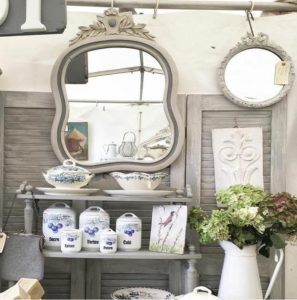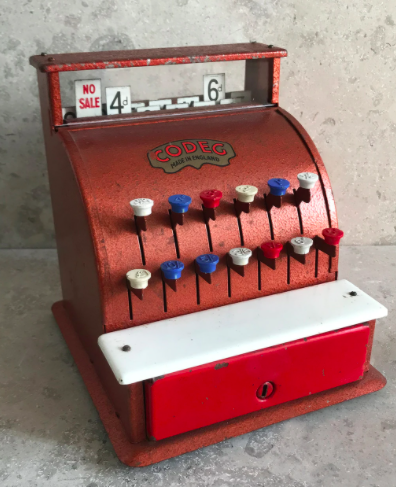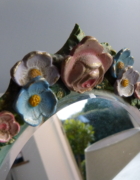It’s almost a cliche to say a lot of vintage business are born from an obsession.
It often starts with the innocent purchase of one little Wedgwood teacup.

All too soon you have fifty tea services, mostly chipped, and spend all your waking hours trawling internets sites, bric-a-brac stalls and auction rooms for old cupboards (woodworm notwithstanding) and you spend £150 on paint to transform a plywood side-table into a Parisian Grey plywood side table.

Then one (or all) of three things will happen.
- You lose a room/shed/loft/conservatory to your finds.
- Your husband says ‘it’s me or the taxidermy moose head’.
- You start to worry if your collection of 132 musty Irish linen table cloths constitute a cute display or a fire hazard.
At this point a ladies’s thoughts (or gents) will turn to trading. After all, what could be simpler than doing a little dabbling in something that you love aka selling your vintage excess to the equally obsessed?
Well, other than doing a Phd in astrophysics, I can’t think of anything more fraught with black-holes. I know, I’ve fallen into most of them.
For starters, if you are serious about running a business then it’s no longer a hobby. To compete alongside fellow traders it means early starts, late finishes and driving miles to find flea markets and charity shops preferably off the beaten track (and often in France).
You’ll also have to develop a knack for spotting trends and advertising those ‘trends’ stylishly on social media. Nothing, I repeat, NOTHING, gets bought or sold until you have done the math or whatever you prefer to call working out your profit margin taking into account everything from the price you paid to oft forgotten costs like postage, eBay/Etsy deductions and your time.

Before you do anything at all, it might do well to heed the advice from Catherine Beck, who Vintage Frills.
‘You’ll never get rich selling vintage,’ she counsels.
That being said, Catherine still believes it’s a business worth pursuing.
‘It’s wonderful doing a job you enjoy and selling something you’re enthusiastic about,’ she concludes.
I hope that outlining all the mistakes I have made will help you on your way. Using some of my own vintage buys as illustrations, here’s how (and how not) to sell vintage. I have also included top tips from people who really know how it’s done

Buy what you like but sell what you love
Lucy Denney, of Bristol, has just set up an Etsy account called Sunny Sundays Vintage selling French posters and other treasures. After the birth of her second child, Lucy decided selling vintage was way of combining work with a little ‘me time’ which combines nicely with being a mum to Stanley, three, and Ted, who is five months.
Like the majority of traders, her new business was born out of her love affair with vintage; “I’ve always enjoyed sourcing lovely things,” she says.

“My passion is for vintage French posters, children’s toys and other bits and bobs and buying is the fun part – actually posting them for sale not so much. I am lucky as I live in Brighton so there are lots of antique/vintage shops for inspiration.”
Unlike Lucy, when I looked for items to list on Etsy, I picked things I no longer wanted to display at home. My first listings included the little ‘Frozen Charlotte’ dolls (see above) which were bought to illustrate an article. They are an interesting item but they say nothing about my brand which is supposed to be cute; not creepy.
Grabbing things because they are unwanted or at hand is a rookie mistake according to Audrey Manning, who writes for the Etsy Seller’s Handbook.
“A vintage brand is more than just a collection of vintage goods,” she says.
“When your business is built on collecting items made by others decades ago, creating your own unique style can be challenging. It takes time but making selective purchases will help you to build your own distinctive brand.”
Do your research before you buy
You have my permission to visit the nearest picturesque town and browse in vintage shops until you are fit to drop into a coffee shop for refreshment (cake).

Look at what they are selling and how they sell it. It may sound like the most fun you can have with your 1940s frock coat on but it’s all research darling.
But don’t buy anything until you’ve done your homework.
When you’ve decided on what you are going to sell – let’s say French enamelware – look at each potential purchase very carefully.
Ask;-
- Is your item authentic
- Is it in good quality vintage condition (a few little chips are okay but a big hole in the bottom of a cafe tin is a big fat non!)
- Will your piece will fit in a modern home?
Take my doll’s house…
In the summer of last year I bought an Edwardian vintage dolls house for £65. It looked Edwardian despite having shiny big brass hinges. My plan was to refurbish the house and sell my miniature treasure for a fat fortune (I saw a 17th Century doll’s house valued for £150,000 on Antique’s Roadshow).
 On taking it for valuation at a local auction house, I discovered my “antique” was only Edwardian in style – it was a modern kit from the 1980s. It was worth £30-50 tops.
On taking it for valuation at a local auction house, I discovered my “antique” was only Edwardian in style – it was a modern kit from the 1980s. It was worth £30-50 tops.
Ouch.
Had I done my research, I’d have known there’s little margin in selling re-conditioned kit houses. Even vintage ones can be a tough sell; most people just don’t have the room for manor houses, even in miniature form.
Vintage doll’s house people, dinky vintage furniture and accessories are often far more saleable.
Fortunately, I enjoyed the refurbishment although ‘fun’ is loose term for trying to un-glue your fingers in a freezing cold shed in mid-November.

If you want to avoid my mistake, don’t buy anything until you’ve looked to see how much similar items are selling for on an auction site like eBay. Don’t just look at the listing price, do an ‘advanced’ search and find out the sold price on the last 20 items most relevant to your potential purchase.

Follow the leaders
Lisa Carter runs Cool Vintage from her home in Michigan and – with her friend Ellen Phillip based in the Ukraine – runs a popular vintage site on Etsy. She’s sold almost 20,000 items she’s sourced from her travels around Europe, particularly from out-of-the-way destinations in Russia and Turkey.
It’s an eclectic, almost magical mix, of items including ‘finds’, archeological items and handmade.
“We fill this store with the most amusing, strange and unique items one can find,” she says.
“We’re always looking for more gorgeous and unique stuff and we’re only sad that the day has only 24 hours.”
Lisa, who has scaled down her business, says it is possible to quit your job to do vintage full-time but it takes a lot of hard work.
“It is possible to make a living wage out of selling vintage,” says Lisa who was listed amongst the top ten vintage sellers on Etsy in 2014.
“I used to have close to 9,000 items in my store. At that time I was listing about 30-40 NEW items every day. You can imagine what kind of commitment it entailed. I employed some part-time help at that time. But my children were school age and I chose to stay at home so income from my store really helped.”


Lou Weaver, of Wiltshire, is a self-confessed vintage magpie who loves selling hand-picked vintage at jumble sales and car boots.
She stresses how important it is to stay on top of trends. “Things go in phases,” Lou explains.
“No one seems to be buying much china these days, so I have a few bits of my stall but not lots. At the moment, good sellers are vintage material and bedding, floral pictures, vintage and pre-loved clothing especially in the bigger sizes and old toys, people are looking to buy their childhoods back.”
For further lessons in loveliness; follow Lou’s Instagram account at vintagevillanelle
Factor in the extra costs
In the 1800s, we had a marvellous postal system. In London, you could send an invitation to a dinner and receive your reply in the afternoon.
If you want to send a small package to the neighbouring town today, you’ll pay the part of a fiver and it will arrive three days later looking as though it has been mauled by a lion.
I sent an etching to a buyer in Paris (yes, I know I was asking for trouble) and was thrilled when the recipient told me his parcel had arrived within two days. Sadly, he was not so happy; the parcel arrived but the contents did not and it was up to me to re-imburse the buyer.
Factor in the cost of packaging and your profits can soon be gobbled up. Every bit of parcel tape counts so try not to get half of it tangled in your hair (invest in a tape dispenser and some scales). Even the eBay best sellers I have spoken to have been caught out by underestimating pricy postage costs.

Jane Eaton runs Cachepot Brocante on Etsy and enjoys selling at vintage markets across the country.
Jane has a home in France and her business was inspired by the elegant items she saw (and bought) at brocante markets. As someone who has to add transportation costs to her finds, Jane also understands the importance of calculating all your costs.
“If you’re pricing items you do have factor in ferry costs, petrol, road toll’s, accommodation and other expenses,” she says.
“Also you have to decide whether to charge your customers for postage or whether to offer free postage in order to attract more business. There are of course ceilings on what you can charge so you need to find out the ‘going rate’ for an item before you buy it.”


Jane Eaton of Cachepot Brocante says she would plump for quality every time but understands why vintage newbies are cautious with their start-up spending.
“When you’re starting up its easier to dip your toe with less expensive items,” she says.
“There’s nothing worse than makings a costly mistake.”

I have bought, and sold, a lot of items over the last few years but the only ones which have delivered a healthy profit have either been vintage must-haves (cute rag dolls or lead toys) or collectibles like the Eileen Soper nursery dish above.
Style is everything – and aim for a cohesive look
Janet Parrella-van den Berg is one of my vintage heroines. Janet is an interior designer, photographer and stylist and you’re going to need all those skills, and more, if you want to stand out from the vintage pack. Taking wonderful photographs is important but styling is everything.

The ‘look’ of your social media account is important because your customers are buying a bit of your lifestyle. It’s worth investing time and effort in getting a professional to design your brand. From the font on your tags to the profile image on your social media account, it should all make one joyously united whole.
‘For a lot of sellers, Instagram is key for growing their customer base,’ says Marygrace Taylor a contributor to style magazine Racked.
‘But pieces aren’t the only things worth posting (on social media). Any kind of image – from a desert sunset to a cityscape to a still from a classic movie – can create a feeling that shows customers what a shop is all about.’

Check potential purchases for faults – and then check again
I collect terriers and by that I mean ceramic figures and not real-life dogs (I have one; never again). For this reason, I once bid over the odds for a massive box of sundry pots at an auction because there was one Beswick fox terrier within.
At least, I thought it was just the one box. On collecting my items the auction porter kept bringing more and more boxes filled with bits of pottery (I began to suspect they were getting rid of all the hideous porcelain they’d had lying around since Whimsie figures were a thing).
I realised I needed to rent a lock-up or list much of the stuff on eBay. Imagine my delight when a cute little Arthur Wood biscuit barrel realised a price of £24 – just £16 pound shy of what I’d paid for the whole lot.
As I wrapped the biscuit barrel for the lady in Minnesota, I discovered a hair-line crack on the rim. It was covered by decades of ancient grime. But I had seen it and I had to come clean.
One swift apology, one speedy refund issued.
The barrel travelled no further than my entrance hall and the shed is still full of crockery my hubby knows nothing about.
But it’s a lesson learned. Even in a big box of ‘bargain’ crockery or glassware, examine every piece.
Here’s how;-
Hold it up to the light – this will expose hairline cracks and reveal places that have been repaired.
Take a magnifying glass to the vintage fair or sale room and don’t be afraid to use it.
Give the rim of your pot a flick with your finger. It should ring. If the sound is flat, there could be a crack.

Don’t pay too much or sell for too little
When you see antique dealers on TV asking for the ‘trade price’ discounts it’s not rude, it’s business. If you want to sell on what you are buying from a shop or market stall, you have to haggle.
Ask for the ‘best price’ – a discount is often factored in. In vintage/antique shops, the dealers may be prepared to offer you a 5-20 per cent discount. But don’t be rude. Remember, these people have bought these goods because they love them and they’ve already factored faults into the price. If you’re offering £12 for a £15 item – play nice and have the right change.
Once the tables are turned and you are selling; the same rules apply. Do offer a small discount but don’t jeopardise your profit to make a sale. Build a little ‘cushion’ into your asking price but don’t be greedy.
Lizzie van Hasselt offers the following advice; “Always put price labels on your items. Be prepared to come down a little. For example, a £12 tag suggests that you would be happy with £10 but no less.”
I paid far too much for Bertie bear at auction. There’s no excuse. The beauty of auctions is that you set your upper limit in advance. I put in a pre-auction bid of £60 thinking it would sell for £25-30. It cost me £56. In spite of my best efforts, I could only achieve £35 on re-sale.

See your potential purchases IRL (in real life)
If you do buy from an auction or internet set without seeing your item ask for a detailed condition report and accurate measurements.
I once confused cms and inches when buying a little picture of a pair of spaniels from an auction. I thought it was tiny but it was almost life-sized and far too big for my walls. I tamed the beasts by selling the picture separately and turning the frame into a mantel mirror at humungous expense.
But I love it; the lyrics about life’s ‘perfect imperfections’ sums up this sob story nicely.

Take your show on the road
Catherine Beck, runs the popular website Vintage Frills says it is vital to explore every selling opportunity.
“There are so many sites out there that the best way to make money selling vintage is offline,” she writes in informative article So You Want to Start a Vintage Business.
“Be prepared to give up your weekend and sign up for every vintage fair, market and vintage event in your area. Stalls can be a little pricey. When I sold at vintage fairs I teamed up with a friend who sold vintage jewellery and we shared a stall. It’s also worth looking into local pop-up shops.”
Sally Knott, who has her own vintage business The Apple Loft, organises – with help from family and friends – beautiful events under the banner The Dorset Brocante. Held three times a year, the events feature 50 stalls including vintage, artisan and foodie pop-ups.
Her top tips to potential stall-holders would be; “Take time to prepare the stall and remember less is more,” she cautions.
“Above all, be different.”
Lizzie van Hasselt sells her swoon-worthy treasures at vintage and textile in the South East. She also urges would-be stall-holders to work on their display skills.


“Presentation of your stand is very important,” says Lizzie who runs The Washerwoman blog.
“Always use clean ironed table cloths, and if the hall is gloomy make sure you have a PAT-tested lamp to brighten the stand. If you are selling clothes, resist the temptation to over-fill the rail, customers need to have space to look at your stock on the rail. All clothing needs to be clean and ironed, and where possible make sure the label shows the price and approximate size of the garment.”
Lizzie is to have a trial-run before you leave the house. “If you have the time and space a mock-up of your stand is a useful exercise as it means you don’t end up taking too much stock. High shelves are good as they put your items at customers eye level. oh, and fresh flowers are always a great extra touch if you can transport them!”
If you are not ready to take that plunge; try village/church fairs and school fetes as a gentle introduction to life as a vintage trader and always take a friend to help.
Finally, be aware that even a little hobby could make you liable for TAX!!!
When in doubt, visit the HMRC website or ring the advice line. They are very helpful and not simply there to take down small business owners with stars in their eyes. Make sure you keep all your receipts and every little bit of expenditure – petrol receipts, parking etc – just in case you do have to fill in a tax return.

Is your primary motive to earn a profit? If HMRC thinks you intended to make money, rather than selling items for fun, the selling activity is considered to be a business.
Above all, don’t lose heart. My Instagram feed is packed with joyous pictures from people who are selling vintage – and doing well – because they clearly love it.
Happy selling.
And if you have any tips, please send me a line.












